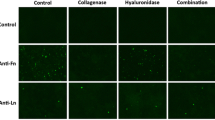Abstract
Increasing the efficiency of gene transfer using non-viral vectors, which have the potential to be safe and economical, would improve upon available options for gene therapy. We previously reported that the third EGF motif of the extracellular matrix protein Del1 (E3) increases the transfection efficiency of non-viral vector methods. Here, we asked if E3 could increase the in vivo transfection efficiency of a polyplex-based approach. To test this, cDNA encoding a heat-stable alkaline phosphatase (AP) was first injected intravenously into mice along with recombinant E3. After 24 h, exogenous AP activity in serum was measured. We found that the introduction of E3 resulted in 50 % more AP activity as compared to the control. We next tested transfection into a tumour explant of SCCKN cells, an oral carcinoma-derived cell line. To do this, a cDNA encoding yellow fluorescent protein was locally injected into a tumour explant, followed by local injection of recombinant E3. Use of E3 increased the number of transfected cells to 2.5 times that of the control. Histochemical staining revealed that E3-induced apoptosis in a tumour explant. The data suggest that E3 might be a useful tool for cancer gene therapy using non-viral vectors.



Similar content being viewed by others
References
Thomas, C. E., Ehrhardt, A., & Kay, M. A. (2003). Progress and problems with the use of viral vectors for gene therapy. Nature Reviews Genetics, 4, 346–358.
Marshall, E. (2000). Gene therapy on trial. Science, 288, 951–957.
Check, E. (2002). Gene therapy: shining hopes dented—but not dashed. Nature, 420, 735.
Magadala, P., & Amiji, M. (2008). Epidermal growth factor receptor-targeted gelatin-based engineered nanocarriers for DNA delivery and transfection in human pancreatic cancer cells. The AAPS Journal, 10, 565–576.
Li, Z., Zhao, R., Wu, X., Sun, Y., Yao, M., Li, J., et al. (2005). Identification and characterization of a novel peptide ligand of epidermal growth factor receptor for targeted delivery of therapeutics. FASEB Journal, 19, 1978–1985.
Saul, J. M., Annapragada, A., Natarajan, J. V., & Bellamkonda, R. V. (2003). Controlled targeting of liposomal doxorubicin via the folate receptor in vitro. Journal of Controlled Release, 92, 49–67.
Zhao, X. B., & Lee, R. J. (2004). Tumor-selective targeted delivery of genes and antisense oligodeoxyribonucleotides via the folate receptor. Advanced Drug Delivery Reviews, 56, 1193–1204.
Oba, M., Fukushima, S., Kanayama, N., Aoyagi, K., Nishiyama, N., Koyama, H., et al. (2007). Cyclic RGD peptide-conjugated polyplex micelles as a targetable gene delivery system directed to cells possessing alphavbeta3 and alphavbeta5 integrins. Bioconjugate Chemistry, 18, 1415–1423.
Kunath, K., Merdan, T., Hegener, O., Haberlein, H., & Kissel, T. (2003). Integrin targeting using RGD-PEI conjugates for in vitro gene transfer. Journal of Gene Medicine, 5, 588–599.
Kitano, H., Hidai, C., Kawana, M., & Kokubun, S. (2008). An epidermal growth factor-like repeat of Del1 protein increases the efficiency of gene transfer in vitro. Molecular Biotechnology, 39, 179–185.
Hidai, C., Zupancic, T., Penta, K., Mikhail, A., Kawana, M., Quertermous, E. E., et al. (1998). Cloning and characterization of developmental endothelial locus-1: An embryonic endothelial cell protein that binds the alphavbeta3 integrin receptor. Genes & Development, 12, 21–33.
Hidai, C., Kawana, M., Habu, K., Kazama, H., Kawase, Y., Iwata, T., et al. (2005). Overexpression of the Del1 gene causes dendritic branching in the mouse mesentery. The Anatomical Record Part A Discoveries in Molecular, Cellular, and Evolutionary Biology, 287, 1165–1175.
Kitano, H., Kokubun, S., & Hidai, C. (2010). The extracellular matrix protein Del1 induces apoptosis via its epidermal growth factor motif. Biochemical and Biophysical Research Communications, 393, 757–761.
Urade, M., Ogura, T., Mima, T., & Matsuya, T. (1992). Establishment of human squamous carcinoma cell lines highly and minimally sensitive to bleomycin and analysis of factors involved in the sensitivity. Cancer, 69, 2589–2597.
Berger, J., Hauber, J., Hauber, R., Geiger, R., & Cullen, B. R. (1988). Secreted placental alkaline phosphatase: A powerful new quantitative indicator of gene expression in eukaryotic cells. Gene, 66, 1–10.
Lowe, M. E. (1992). Site-specific mutations in the COOH-terminus of placental alkaline phosphatase: A single amino acid change converts a phosphatidylinositol-glycan-anchored protein to a secreted protein. Journal of Cell Biology, 116, 799–807.
Bowers, W. J., Breakefield, X. O., & Sena-Esteves, M. (2011). Genetic therapy for the nervous system. Human Molecular Genetics, 20, R28–R41.
Kuwahara, H., Nishina, K., Yoshida, K., Nishina, T., Yamamoto, M., Saito, Y., et al. (2011). Efficient in vivo delivery of siRNA into brain capillary endothelial cells along with endogenous lipoprotein. Molecular Therapy, 19, 2213–2221.
Litzinger, D. C., Brown, J. M., Wala, I., Kaufman, S. A., Van, G. Y., Farrell, C. L., et al. (1996). Fate of cationic liposomes and their complex with oligonucleotide in vivo. Biochimica et Biophysica Acta, 1281, 139–149.
Hidai, C., Kawana, M., Kitano, H., & Kokubun, S. (2007). Discoidin domain of Del1 protein contributes to its deposition in the extracellular matrix. Cell and Tissue Research, 330, 83–95.
Hidai, C., Kitano, H., & Kokubun, S. (2009). The Del1 deposition domain can immobilize 3alpha-hydroxysteroid dehydrogenase in the extracellular matrix without interfering with enzymatic activity. Bioprocess and Biosystems Engineering, 32, 569–573.
Kitano, H., Mamiya, A., & Hidai, C. (2011). Improvement of FasL gene therapy in vitro by fusing the FasL to Del1 protein domains. In Y. You (Ed.), Targets in Gene Therapy. Croatia: In Tech Rijeka.
Acknowledgments
This study was supported by Grant 04-162 from the Japan Science and Technology Agency. We thank Y. Hayashido for kindly providing SCCKN cells and T. Quertermous for kindly providing the Del1 cDNA. English editing was done by FORTE Science Communications.
Conflict of Interest
The authors indicate that they have no competing financial interests.
Author information
Authors and Affiliations
Corresponding author
Rights and permissions
About this article
Cite this article
Mamiya, A., Kitano, H., Takao, K. et al. An Epidermal Growth Factor Motif from Del1 Protein Increases the Efficiency of In Vivo Gene Transfer with a Non-Viral Vector. Mol Biotechnol 54, 445–450 (2013). https://doi.org/10.1007/s12033-012-9582-z
Published:
Issue Date:
DOI: https://doi.org/10.1007/s12033-012-9582-z




